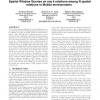MDM
2005
Springer
14 years 5 months ago
2005
Springer
The ever-increasing popularity of mobile applications coupled with the prevalence of spatial data has created the need for efficient processing of spatial queries in mobile enviro...
KI
2005
Springer
14 years 5 months ago
2005
Springer
To reason about geographical objects, it is not only necessary to have more or less complete information about where these objects are located in space, but also how they can chang...
ILP
2005
Springer
14 years 5 months ago
2005
Springer
Clustering is a fundamental task in Spatial Data Mining where data consists of observations for a site (e.g. areal units) descriptive of one or more (spatial) primary units, possib...
SAC
2005
ACM
14 years 5 months ago
2005
ACM
Many geographical applications deal with spatial objects that cannot be adequately described by determinate, crisp concepts because of their intrinsically indeterminate and vague ...
ICDM
2005
IEEE
14 years 5 months ago
2005
IEEE
Spatial co-location patterns represent the subsets of features whose instances are frequently located together in geographic space. Co-location pattern discovery presents challeng...
MM
2006
ACM
14 years 5 months ago
2006
ACM
Human vision system actively seeks interesting regions in images to reduce the search effort in tasks, such as object detection and recognition. Similarly, prominent actions in v...
GIR
2006
ACM
14 years 5 months ago
2006
ACM
Retrieving data based not only on key words is a challenge. We worked on semi-structured data (cultural heritage corpora). Our project aimed at getting the most relevant text-unit...
DOLAP
2006
ACM
14 years 5 months ago
2006
ACM
Decision support systems (DSS) may be enhanced qualitatively if they are able to also deal with spatial dimensions and measures. Regardless the evident importance of using data wa...
ICTAI
2006
IEEE
14 years 5 months ago
2006
IEEE
The goal of spatial co-location pattern mining is to find subsets of spatial features frequently located together in spatial proximity. Example co-location patterns include servi...
CVPR
2006
IEEE
14 years 6 months ago
2006
IEEE
This paper presents an extension to category classification with bag-of-features, which represents an image as an orderless distribution of features. We propose a method to explo...



